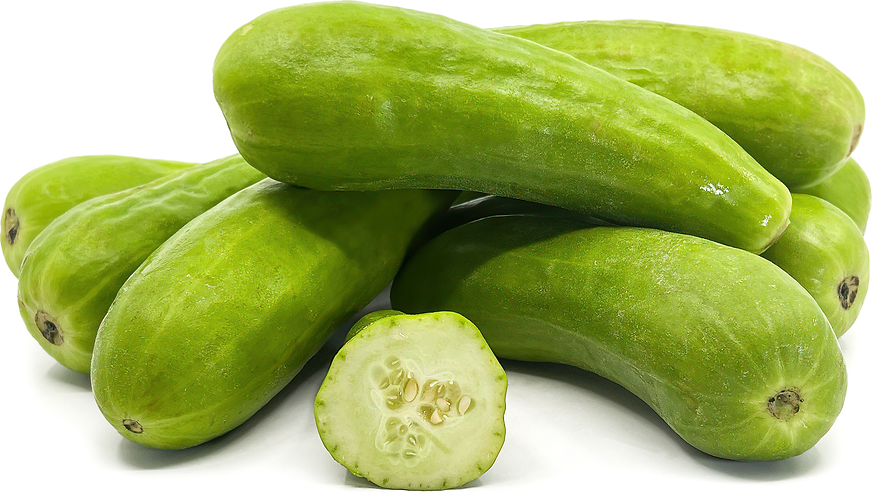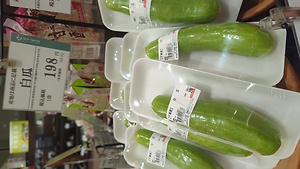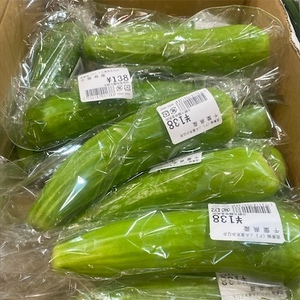


Shirouri Cucumbers
Estimated Inventory, lb : 0
Description/Taste
Shirouri cucumbers are a medium to large varietal, averaging 20 to 30 cm in length and 3 to 7 centimeters in diameter, and have a cylindrical shape with curved, blunt ends. Some varieties of Shirouri may be short, while others are more elongated, and the skin is semi-thin, taut, and glossy, ripening from pale green, yellow-green, to white. The skin may also be smooth or grooved, depending on the cultivar. Underneath the surface, the pale green to white flesh is dense, firm, and less aqueous than a common commercial cucumber. The flesh also contains central chambers filled with small, oval, ivory seeds and has a crisp and crunchy texture when raw, softening once cooked. Shirouri cucumbers do not emit the characteristic grassy scent of other cucumber varieties and should feel heavy for their size when selecting for culinary preparations. The cucumbers are edible raw or cooked and have a light, mild, and neutral taste.
Seasons/Availability
Shirouri cucumbers are harvested in the summer in Japan from May to September, with a peak season in June.
Current Facts
Shirouri, botanically a part of the Cucumis genus, is a category of several varieties of pickling cucumbers, sometimes referred to as melons in Japanese translations, belonging to the Cucurbitaceae family. The name Shirouri translates from Japanese to mean “White Melon or Cucumber,” and the cucumbers acquired this moniker as the skin typically transitions from pale green to white when ripe. Shirorui cucumbers are native to Asia, and many different types are found under regional names throughout China, Japan, and Korea. The cucumbers are considered a variant of Makuwa Uri or an Oriental Pickling cucumber, and Shirouri is also known as Yue Uri, Asauri, Tsukeuri, and Aori. Throughout Japan, there are several well-known varieties of Shirouri cultivated in various prefectures, including Numame Shirouri in Nagano, Oo-Shirouri, Tokyo Dai White, Tokyo Wase White, and Katsura in Tokyo, Sanuki Shirouri in Kagawa, and Numame White in Tohoku. Shirouri is associated with summer in Japan, and the seasonal cucumbers are favored for their crunchy texture and mild flavor. The cucumbers are typically pickled and infused with sweet and sour ingredients to create a tangy condiment or snack.
Nutritional Value
Shirouri is a source of fiber to regulate the digestive tract, potassium to balance fluid levels within the body, vitamin K to build protein for generating bones and tissue healing, and folate to develop red blood cells. Like other pickling melons, Shirouri also provides vitamin C to boost the immune system, vitamin A to maintain healthy organs, magnesium to control nerve operations, and other nutrients, including phosphorus and iron. In natural medicines in Japan, Shirouri is viewed as an ingredient to improve digestion and reduce swelling.
Applications
Shirouri has a light, refreshing, and neutral taste suited for fresh, cooked, and pickled preparations. The cucumbers are typically sliced in half lengthwise, and the seeds are removed from the flesh with a spoon. The skin can be peeled or left intact, depending on preference, and the flesh is often sprinkled with salt to remove excess moisture. Once the salt is rinsed or wiped off the surface, the cucumbers can be sliced and tossed into salads, chopped and mixed into dips, or served as a crisp, mild appetizer. It is recommended to select average-sized Shirouri as larger ones may develop a hollow interior. Pale green to yellow-green Shirouri will have a crisper texture, while white-hued cucumbers are slightly softer. In Japan, Shirouri is famous for pickling. The cucumbers can be utilized in various pickle styles, including shochu, miso, nukazuke, and narazuke, and they are often fermented in a sweet and sour mixture to create a dynamic flavor. Shirouri can also be incorporated into aemono, a dish of fresh, dressed vegetables in a sauce, or added to stir-fries with chile peppers, vegetables, and meat. In addition to pickles and stir-fries, Shirouri is commonly simmered into soups and stews, developing a softer texture. Cucumber soups can be served hot or chilled, and Shirouri can also be boiled in dashi as a simple side dish. One distinct method of preparing Shirouri is by making kaminari boshi, a name roughly translating from Japanese to mean “dried thunder and lightning.” The cucumbers are sliced into spirals, sprinkled with salt, and air-dried to create a chewy, crunchy, and salty snack. They are often hung from ceilings to dry and stretch out into long spirals, said to resemble the shape of lightning. Shirouri cucumbers pair well with flavorings such as mirin, ponzu, soy sauce, mustard, and sweet vinegar, shisho leaves, shimeji mushrooms, bitter gourd, tomatoes, ginger, and meats such as pork, poultry, or beef. Whole, unwashed Shirouri does not have a long shelf life and should be immediately consumed for the best quality and flavor. The cucumbers can also be wrapped in newspaper or plastic and stored in the refrigerator's vegetable drawer for a few days.
Ethnic/Cultural Info
Shirouri cucumbers were famously used in Narazuke, a traditional Japanese pickle made from sake and mirin. Shirouri Narazuke was created in the Tamazukuri area of Osaka, as the cucumbers were grown near Osaka Castle and the Tamazukuri Inari Shrine. In the middle of the Edo period, sake brewers moved to Tamazukuri because the shogunate granted rights to brew sake in the region. During this time, Shirouri Narazuke was developed from using sake lees or sake kasu, a by-product of sake production. This by-product helped to create the tangy, salty, and crunchy pickles, and Shirouri Narazuke quickly became a specialty item of the Tamazukuri region. Over time, sake production decreased, reducing the cultivation of Shirouri cucumbers in the area. In 2004, Shirouri cucumbers were revived in Tamazukuri by establishing an annual festival in July. The Kuromon Shirouri festival honors the historical cultivation of the cucumbers near Osaka Castle and the Inari Shrine, and a stone monument was erected in the fields near the shrine to mark its significance. The festival also sells Shirouri Narazuke and other cucumber-centric products, and Shirouri cucumbers are offered fresh to visitors to sample and appreciate the locally produced cucumbers.
Geography/History
Shirouri cucumbers are descendants of varieties native to India that were spread across Asia through trade routes and migrating peoples. Once the ancient descendants were introduced into Japan, new varieties were created through cultivation, eventually developing Shirouri cucumbers. In Japan, Shirouri cucumbers have been present in cultivation since the Yayoi Period, 300 BCE to 250 CE, and traces of seeds have been found in excavated ruins. The cucumbers were also grown in Osaka during the Edo Period and were notably mentioned in poetry written by Sadayanagi in the late 18th century. They have also been grown in the Kagawa Prefecture since the Meiji Period, 1868 to 1912 CE, and in the Nagano Prefecture during the Taisho Period, 1912 to 1926 CE. Today, Shirouri cucumbers are commercially grown across Japan and are primarily found in the Tokushima, Nagano, Kagawa, and Tokyo Prefectures and in the Tohoku region. The Shirouri cucumbers featured in the photograph above were sourced through Cold Storage in Tokyo, Japan.
Recipe Ideas
Recipes that include Shirouri Cucumbers. One
| Foodist |
|
Sweet and Sour Pickled Shirouri |
| Woman Excite |
|
Stir-Fried Shirouri Cucumbers with Sesame Oil |
| Nadia Recipes |
|
Stewed Shirouri |









